Low Stress Level and Low Stress Amplitude Fatigue Loading Simulation of Concrete Components Containing Cold Joints under Fatigue Loading
Abstract
:1. Introduction
2. The Cohesive Force Fatigue Damage Constitutive Model
2.1. Damage Calculation
2.2. Implementation Process
3. Numerical Calculation Models
3.1. Model Dimensions
3.2. Material Parameters
3.3. Boundary Conditions and Loading Steps
4. Inversion of Fatigue Damage Parameters
4.1. Experiment
4.2. BP Neural Network
4.3. Dataset Construction
4.4. Parameter Inversion
5. Analysis of Calculation Results
5.1. Fatigue Life
- (1)
- The predicted values of fatigue life from the numerical model for each group of specimens fall between the maximum and minimum measured fatigue life values, and are close to the average fatigue life. This closeness to experimental results validates the reliability of the cohesive fatigue damage elements and the parameters inversely calculated by the BP neural network. The developed cohesive fatigue damage elements and the inversely calculated material parameters can be extended for analyzing the damage of concrete structures with cold joints under aerodynamic fatigue loads of high-speed trains and predicting the crack initiation time of cold joint interfaces.
- (2)
- When the initial stress level is low, the cold joint components do not experience fatigue fracture at any cyclic strength, validating the assumption regarding the cohesive fatigue limit made earlier. Below the fatigue limit, the material can undergo an infinite number of cycles without failure. With increasing initial stress level, the components with an 8-h pouring interval are the first to experience fatigue fracture, and their fatigue life gradually decreases with increasing cyclic strength. Next are the components with a 4-h pouring interval, and those with a 2-h pouring interval experience fatigue fracture last. The pouring interval is the primary factor affecting the strength of the cold joint interface, and the strength of the cold joint interface determines the bearing capacity of the concrete components with cold joints. Therefore, the starting conditions for fatigue damage for cold joints with pouring intervals of 8 h and 4 h are much lower than those for cold joints with a pouring interval of 2 h.
- (3)
- As the casting interval increases, the area enclosed by the polygon formed by the maximum and minimum cycle counts gradually decreases, indicating a reduction in the dispersion of component fatigue life with increasing casting interval. Combined with nanoindentation experimental results, when the casting interval is short, the hydration between the first and subsequent castings is very strong. As a result, the interface strength is high and the thickness is large, leading to a high degree of randomness in the crack propagation path under fatigue loading, thus resulting in a large dispersion of fatigue life, as shown in Figure 10a. With increasing casting interval, the hydration at the surface of the first casting gradually diminishes, resulting in weaker and thinner interface regions. Consequently, the randomness of crack propagation paths decreases, leading to a smaller dispersion of fatigue life, as illustrated in Figure 10b [18]. The influence of cold joint interface thickness on fatigue damage and life dispersion was not considered in the numerical simulation. Hence, the fatigue life is a deterministic value. Further research can be conducted in subsequent work to investigate the effect of cold joint interface thickness on cold joint fatigue damage and life dispersion.
5.2. Cracking Process and Cold Joint Damage
- (1)
- The developed cohesive fatigue damage element and inverse parameters can effectively simulate the cracking behavior of cold joint components under cyclic loading conditions. When initial stress is applied to the model, no cracking occurs at the cold joint interface. At this stage, only static damage is present at the cold joint interface, and the total damage is less than 1. Subsequently, fatigue loading is applied to the model, and after reaching a certain number of cycles, fatigue damage starts to appear in the cohesive elements. When the accumulated value of static and fatigue damage reaches 1, the corresponding element fails and is automatically removed, resulting in the generation of macroscopic cracks in the model.
- (2)
- With an increase in the number of cycles, the cold joint interface elements first experience fatigue damage failure near the pre-existing crack, followed by gradual fatigue damage failure of subsequent elements. This is manifested in the model by a gradual increase in the length of macroscopic cracks. When the macroscopic crack extends to a certain length, the component can no longer withstand static and fatigue loads. At this point, the numerical simulation software indicates a computational error and automatically stops the calculation.
6. Conclusions
- (1)
- The developed cohesive fatigue damage elements are suitable for simulating the fatigue fracture behavior of concrete components with cold joints under low stress amplitude fatigue loading. The small error between the fatigue life calculated based on the fatigue damage element parameters obtained from the inverse process using the BP neural network and the experimental results verifies the reliability of the cohesive fatigue damage elements and the inverse parameters using the BP neural network. The developed cohesive fatigue damage elements and the corresponding fatigue damage parameters can be used to analyze the damage of concrete lining with cold joints under aerodynamic fatigue loading and predict the timing of cold joint cracking.
- (2)
- For cold joints with casting intervals of 2, 4, and 8 h, the corresponding initial normal strengths are 0.58 MPa, 0.36 MPa, and 0.28 MPa, respectively. The fatigue limits are 0.48, 0.42, and 0.34, respectively. The initial cohesive lengths are 0.0007 mm, 0.0004 mm, and 0.0002 mm, respectively. The initial strength and fatigue damage initiation conditions of the cold joint interface decrease with the increase of pouring interval.
- (3)
- The variability of fatigue life of concrete components with cold joints decreases with the increase of casting interval. The thickness of the cold joint interface is the main factor affecting the variability of fatigue life. Subsequent research can investigate the influence of interface thickness on the fatigue life of concrete components with cold joints.
Author Contributions
Funding
Institutional Review Board Statement
Informed Consent Statement
Data Availability Statement
Acknowledgments
Conflicts of Interest
References
- Kachkouch, F.Z.; Noberto, C.C.; de Albuquerque Lima Babadopulos, L.F.; Melo, A.R.S.; Machado, A.M.L.; Sebaibi, N.; Boukhelf, F.; El Mendili, Y. Fatigue behavior of concrete: A literature review on the main relevant parameters. Constr. Build. Mater. 2022, 338, 127510. [Google Scholar] [CrossRef]
- Fan, J.; Jiang, D.; Chen, J.; Liu, W.; Tiedeu Ngaha, W.; Chen, J. Fatigue performance of ordinary concrete under discontinuous cyclic loading. Constr. Build. Mater. 2018, 166, 974–981. [Google Scholar] [CrossRef]
- Gao, R.; He, J. Seismic performance assessment of concrete bridges with traffic-induced fatigue damage. Eng. Fail. Anal. 2022, 134, 106042. [Google Scholar] [CrossRef]
- Liu, M.; Lu, J.; Jiang, W.; Ming, P. Study on fatigue damage and fatigue crack propagation of rubber concrete. J. Build. Eng. 2023, 65, 105718. [Google Scholar] [CrossRef]
- Yadav, I.N.; Thapa, K.B. Fatigue damage model of concrete materials. Theor. Appl. Fract. Mech. 2020, 108, 102578. [Google Scholar] [CrossRef]
- Riyar, R.L.; Mansi; Bhowmik, S. Fatigue behaviour of plain and reinforced concrete: A systematic review. Theor. Appl. Fract. Mech. 2023, 125, 103867. [Google Scholar] [CrossRef]
- Al-Saoudi, A.; Kalfat, R.; Al-Mahaidi, R. Investigation into the fatigue life of FRP strengthened concrete structures. Mater. Struct. 2021, 55, 6. [Google Scholar] [CrossRef]
- Kasu, S.R.; Deb, S.; Mitra, N.; Muppireddy, A.R.; Kusam, S.R. Influence of aggregate size on flexural fatigue response of concrete. Constr. Build. Mater. 2019, 229, 116922. [Google Scholar] [CrossRef]
- Accornero, F.; Rubino, A.; Carpinteri, A. Ultra-low cycle fatigue (ULCF) in fibre-reinforced concrete beams. Theor. Appl. Fract. Mech. 2022, 120, 103392. [Google Scholar] [CrossRef]
- Vicente, M.A.; González, D.C.; Mínguez, J.; Tarifa, M.A.; Ruiz, G.; Hindi, R. Influence of the pore morphology of high strength concrete on its fatigue life. Int. J. Fatigue 2018, 112, 106–116. [Google Scholar] [CrossRef]
- Chandrappa, A.K.; Biligiri, K.P. Effect of pore structure on fatigue of pervious concrete. Road Mater. Pavement Des. 2019, 20, 1525–1547. [Google Scholar] [CrossRef]
- Wu, B.; Jin, H. Compressive fatigue behavior of compound concrete containing demolished concrete lumps. Constr. Build. Mater. 2019, 210, 140–156. [Google Scholar] [CrossRef]
- Sun, J.; Ding, Z.; Huang, Q. Corrosion fatigue life prediction for steel bar in concrete based on fatigue crack propagation and equivalent initial flaw size. Constr. Build. Mater. 2019, 195, 208–217. [Google Scholar] [CrossRef]
- Deng, H.-S.; Fu, H.-L.; Wu, Y.-M.; Zhao, Y.-B.; Yi, H.-D. Numerical simulation method and deterioration analysis of load-bearing performance of tunnel linings containing cold joints in plain concrete. Tunn. Undergr. Space Technol. 2024, 144, 105561. [Google Scholar] [CrossRef]
- Fu, H.-L.; Deng, H.-S.; Zhang, J.; Shi, Y.; Huang, X. Experimental analysis of influence of pouring interval on fracture performance of concrete structures with cold joints. Theor. Appl. Fract. Mech. 2022, 118, 103289. [Google Scholar] [CrossRef]
- Deng, H.-S.; Fu, H.-L.; Chen, W.; Zhao, Y.-B.; Yi, H.-D. Study on deterioration, cracking mechanism and treatment measures of plain concrete lining with cold joints in high-speed railroad tunnel. Case Stud. Constr. Mater. 2023, 18, e01895. [Google Scholar] [CrossRef]
- Asakura, T.; Kojima, Y. Tunnel maintenance in Japan. Tunn. Undergr. Space Technol. 2003, 18, 161–169. [Google Scholar] [CrossRef]
- Deng, H.-S.; Fu, H.-L.; Wu, Y.-M.; Zhao, Y.-B.; Yi, H.-D. Fatigue fracture experiment of concrete members with cold joints under low stress and low stress amplitude fatigue load. Theor. Appl. Fract. Mech. 2023, 127, 104041. [Google Scholar] [CrossRef]
- Wang, Q.; Hu, Z.; Liang, X.; Wu, Y.; Zhou, W.; Yang, Y.; Xu, X.; Wang, S. Experimental simulation of alternating aerodynamic loads induced by high-speed trains passing in tunnels. Proc. Inst. Mech. Eng. Part F J. Rail Rapid Transit 2023, 237, 1176–1184. [Google Scholar] [CrossRef]
- Nguyen, O.; Repetto, E.; Ortiz, M.; Radovitzky, R. A cohesive model of fatigue crack growth. Int. J. Fract. 2001, 110, 351–369. [Google Scholar] [CrossRef]
- Needleman, A. An analysis of tensile decohesion along an interface. J. Mech. Phys. Solids 1990, 38, 289–324. [Google Scholar] [CrossRef]
- Roe, K.L.; Siegmund, T. An irreversible cohesive zone model for interface fatigue crack growth simulation. Eng. Fract. Mech. 2003, 70, 209–232. [Google Scholar] [CrossRef]
- Li, H.; Li, C.; Yuan, H. Prediction of fatigue crack growth retardation using a cyclic cohesive zone model. Arch. Appl. Mech. 2017, 87, 1061–1075. [Google Scholar] [CrossRef]
- Choi, H.; Park, K.; Paulino, G.H. Mixed-mode fatigue crack growth using cohesive zone modeling. Eng. Fract. Mech. 2020, 240, 107234. [Google Scholar] [CrossRef]
- Barenblatt, G.I. The Mechanical Theory of Equilibrium Cracks in Brittle Fracture. Adv. Appl. Mech. 1962, 7, 55–129. [Google Scholar]
- Hillerborg, A.; Modéer, M.; Petersson, P.-E. Analysis of crack formation and crack growth in concrete by means of fracture mechanics and finite elements. Cem. Concr. Res. 1976, 6, 773–781. [Google Scholar] [CrossRef]
- Ural, A.; Krishnan, V.R.; Papoulia, K.D. A cohesive zone model for fatigue crack growth allowing for crack retardation. Int. J. Solids Struct. 2009, 46, 2453–2462. [Google Scholar] [CrossRef]
- Zhang, W.; Tabiei, A. Improvement of an Exponential Cohesive Zone Model for Fatigue Analysis. J. Fail. Anal. Prev. 2018, 18, 607–618. [Google Scholar] [CrossRef]
- Deng, H.-S.; Fu, H.-L.; Li, H.; Shi, Y.; Huang, Z. Fracture performance and fracture characteristics of concrete members with cold joints: Numerical simulation. Theor. Appl. Fract. Mech. 2023, 125, 103868. [Google Scholar] [CrossRef]
- Le Minh, H.; Khatir, S.; Abdel Wahab, M.; Cuong-Le, T. A concrete damage plasticity model for predicting the effects of compressive high-strength concrete under static and dynamic loads. J. Build. Eng. 2021, 44, 103239. [Google Scholar] [CrossRef]
- Li, X.-X. Parametric study on numerical simulation of missile punching test using concrete damaged plasticity (CDP) model. Int. J. Impact Eng. 2020, 144, 103652. [Google Scholar] [CrossRef]
- Othman, H.; Marzouk, H. Applicability of damage plasticity constitutive model for ultra-high performance fibre-reinforced concrete under impact loads. Int. J. Impact Eng. 2018, 114, 20–31. [Google Scholar] [CrossRef]
- Patino-Ramirez, F.; Wang, Z.J.; Chau, D.H.; Arson, C. Back-calculation of soil parameters from displacement-controlled cavity expansion under geostatic stress by FEM and machine learning. Acta Geotech. 2023, 18, 1755–1768. [Google Scholar] [CrossRef]
- Huang, C.-C. Back-calculating strength parameters and predicting displacements of deep-seated sliding surface comprising weathered rocks. Int. J. Rock Mech. Min. Sci. 2016, 88, 98–104. [Google Scholar] [CrossRef]
- Mackiewicz, P.; Szydło, A. Viscoelastic Parameters of Asphalt Mixtures Identified in Static and Dynamic Tests. Materials 2019, 12, 2084. [Google Scholar] [CrossRef] [PubMed]
- Dávila, C.G. From S-N to the Paris law with a new mixed-mode cohesive fatigue model for delamination in composites. Theor. Appl. Fract. Mech. 2020, 106, 102499. [Google Scholar] [CrossRef]
- Zhao, G.; Zhong, J.; Feng, C.; Liang, Z. Simulation of ultra-low cycle fatigue cracking of coiled tubing steel based on cohesive zone model. Eng. Fract. Mech. 2020, 235, 107201. [Google Scholar] [CrossRef]
- Leciñana, I.; Zurbitu, J.; Renart, J.; Turon, A. A robust fatigue parameter determination method for a local fatigue cohesive zone model. Int. J. Fatigue 2023, 171, 107582. [Google Scholar] [CrossRef]
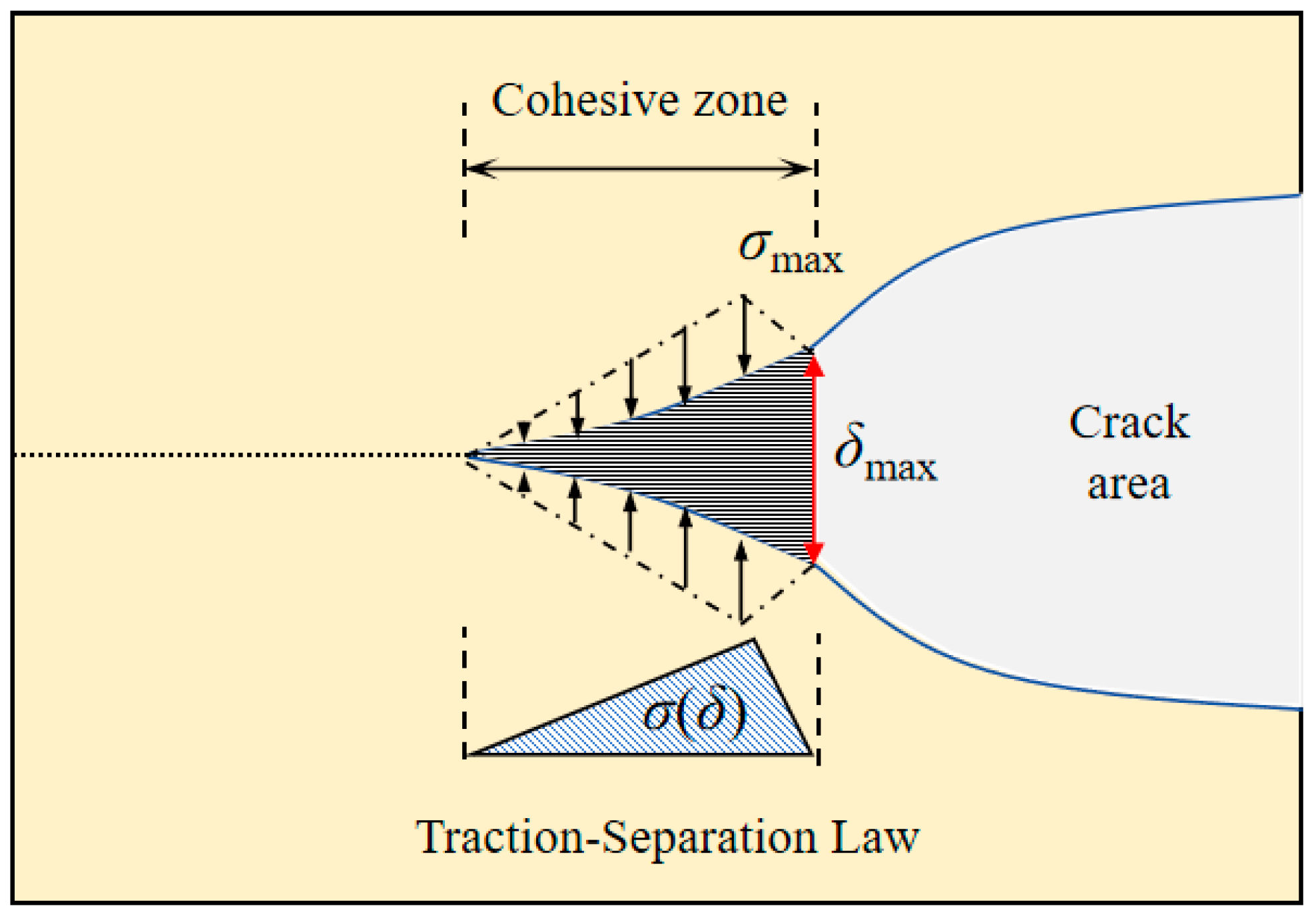
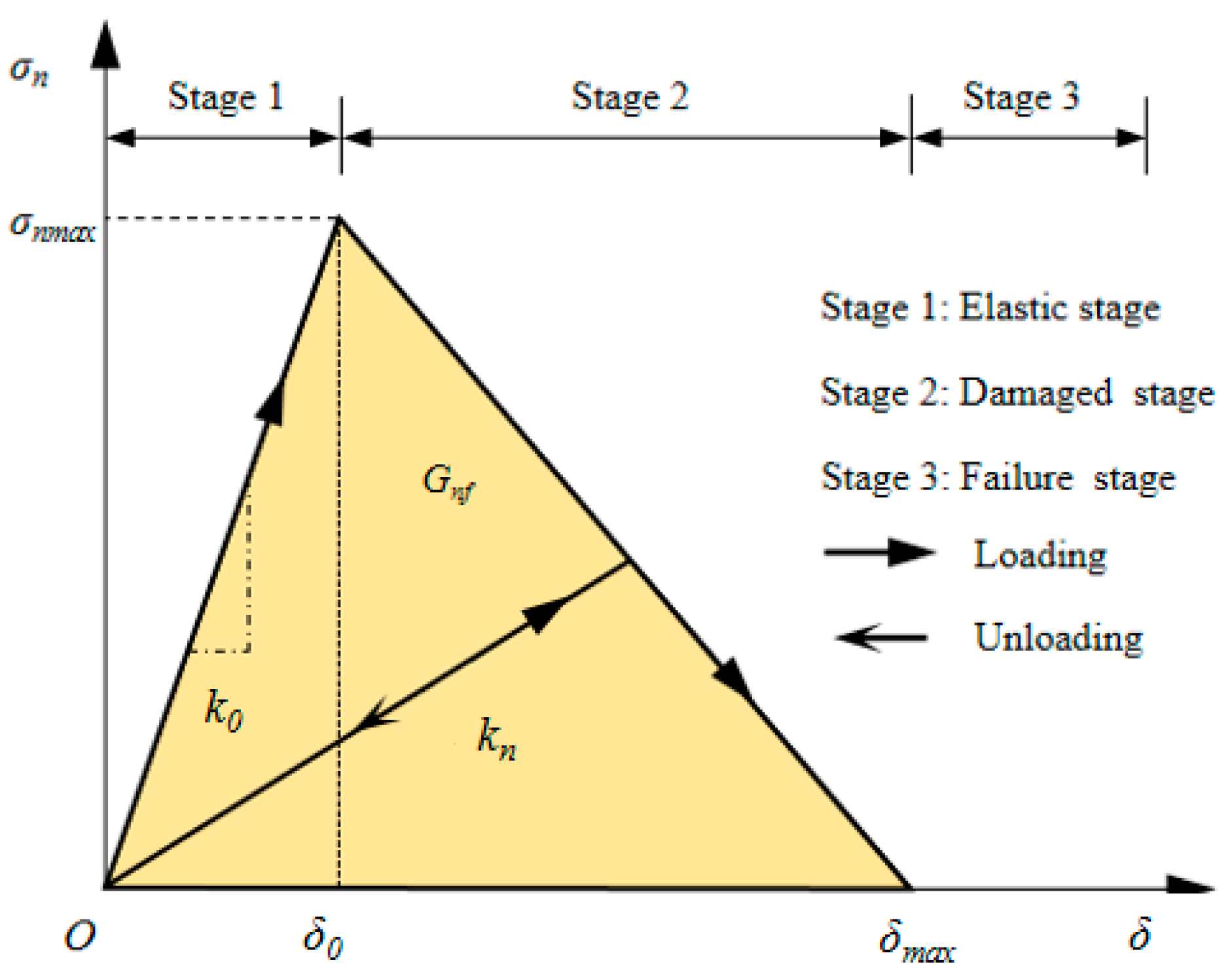
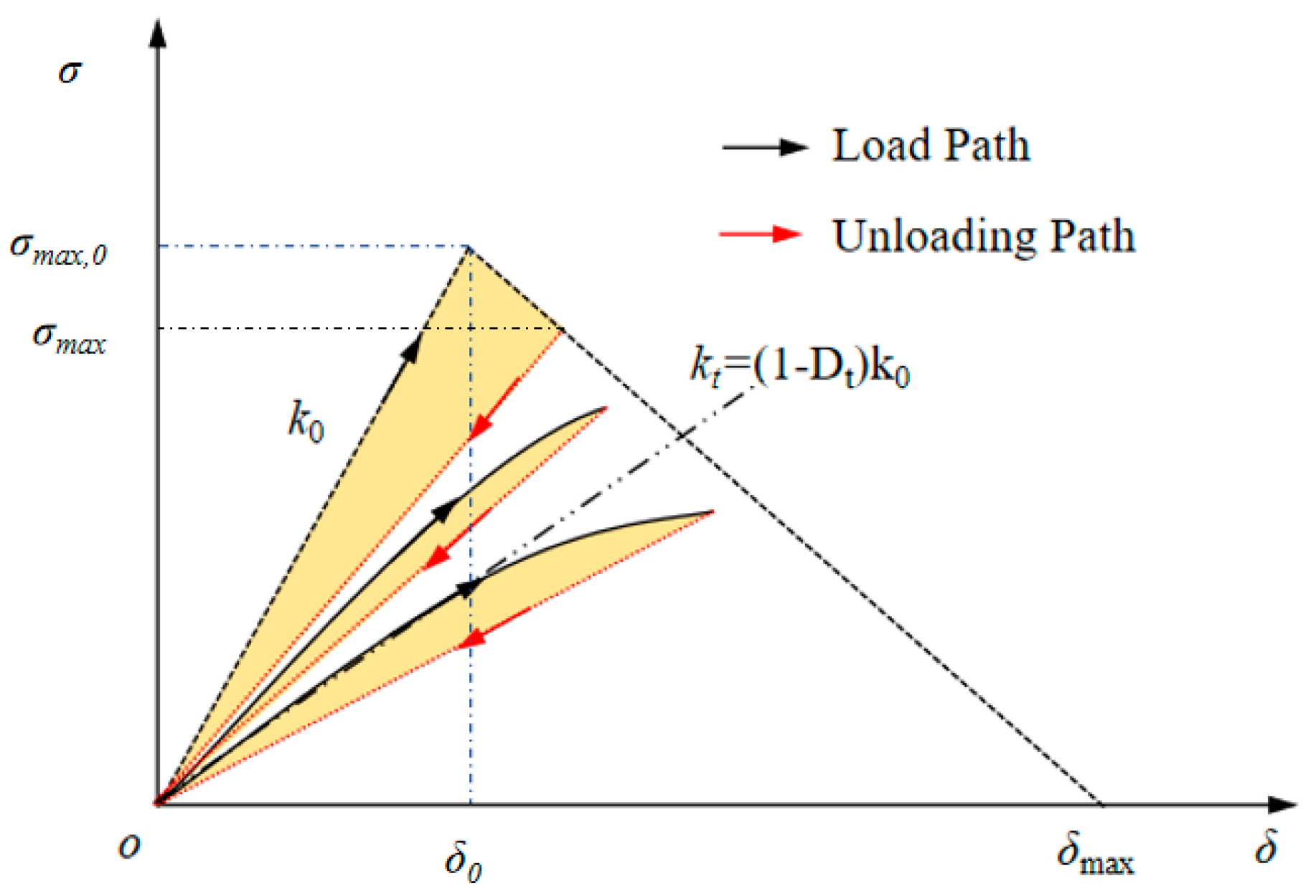
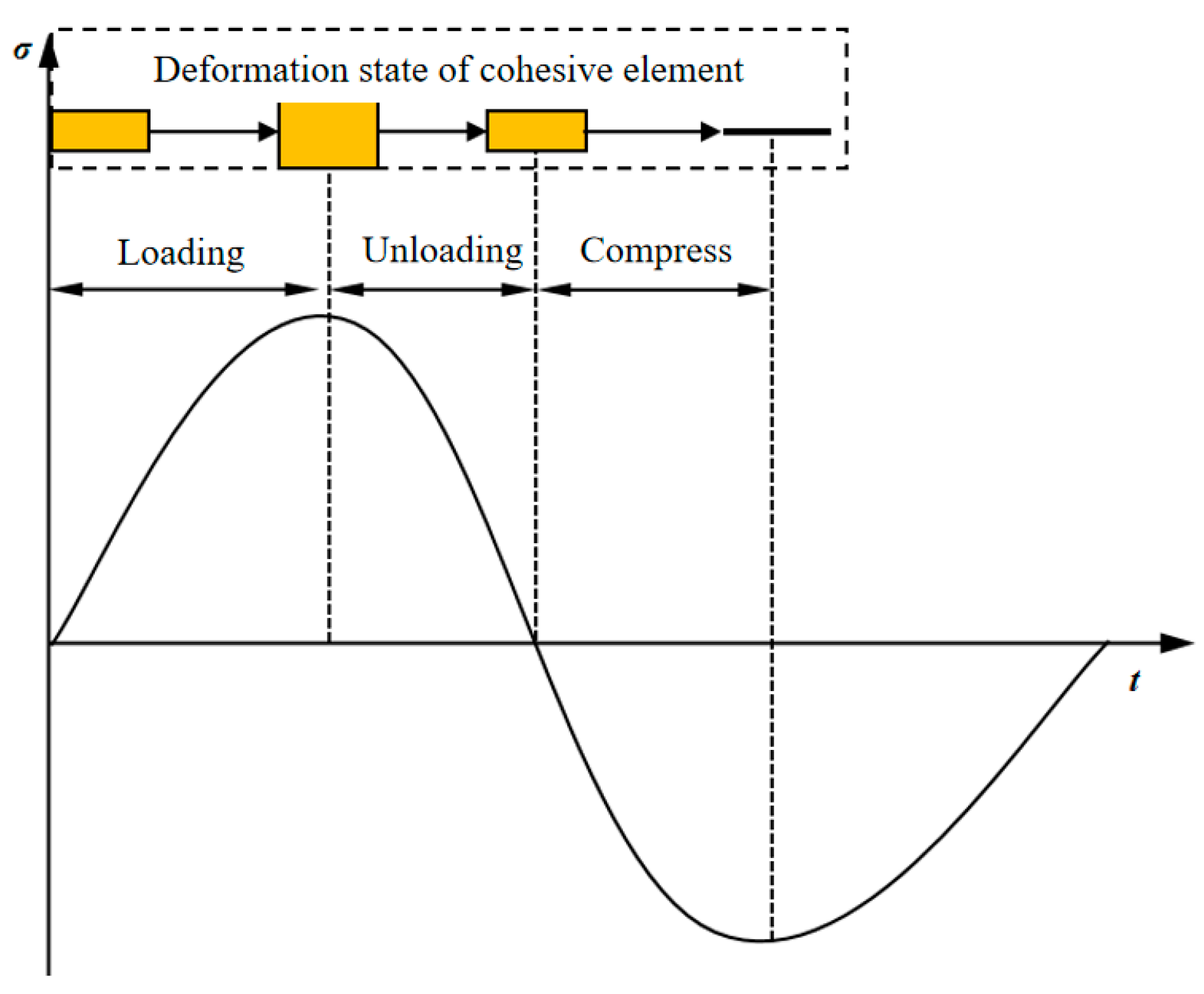
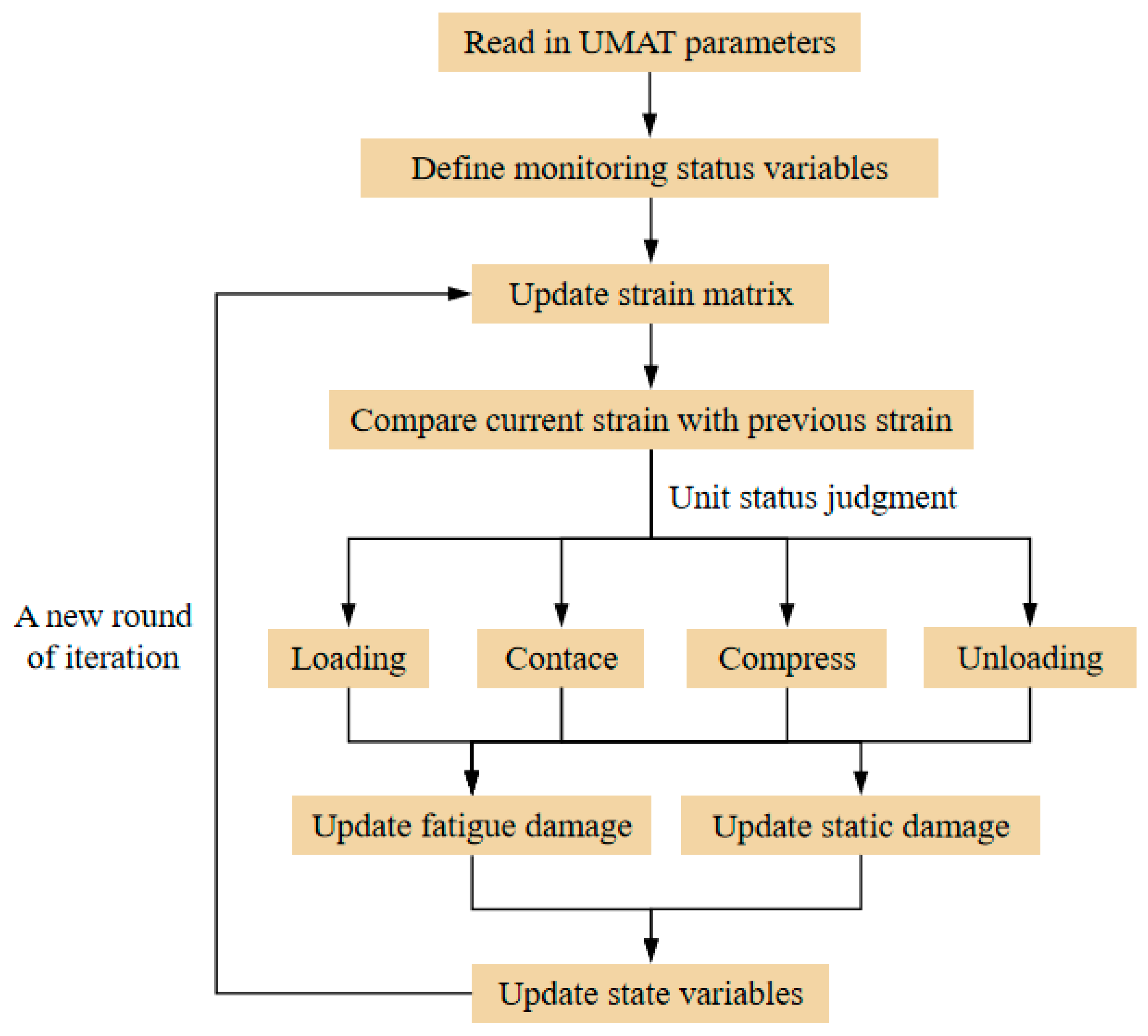
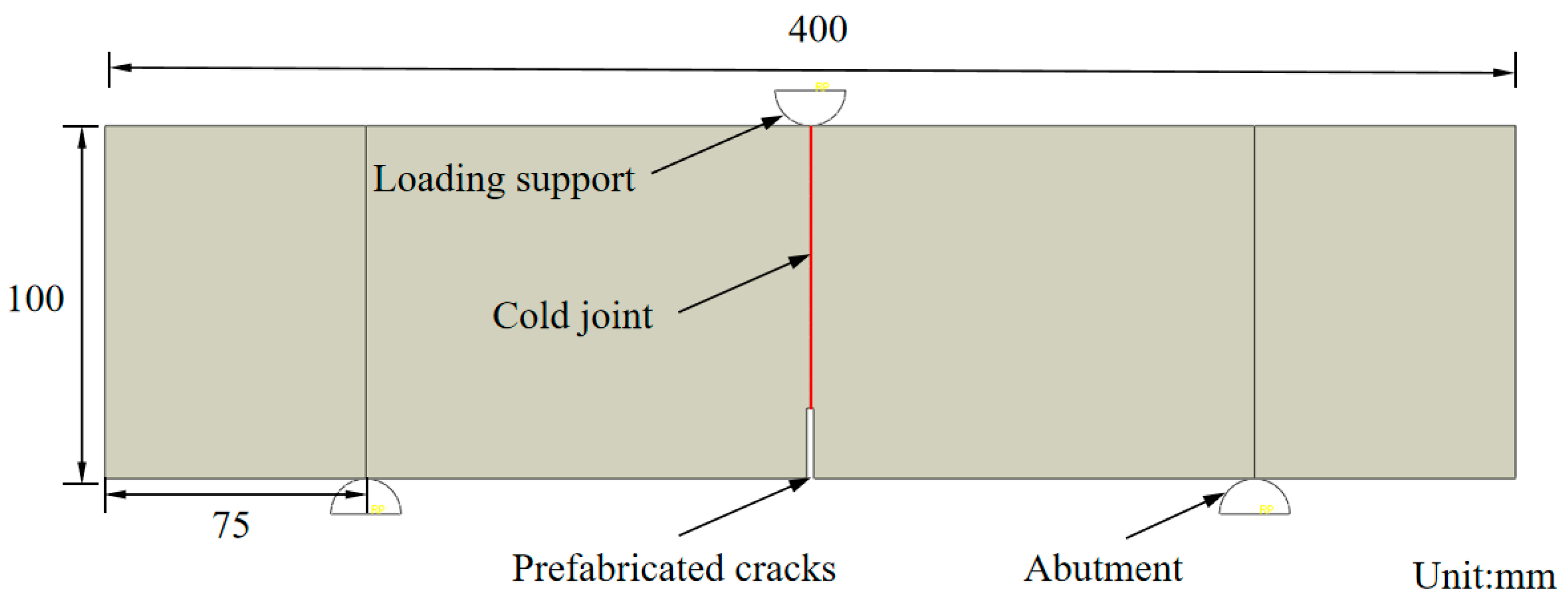


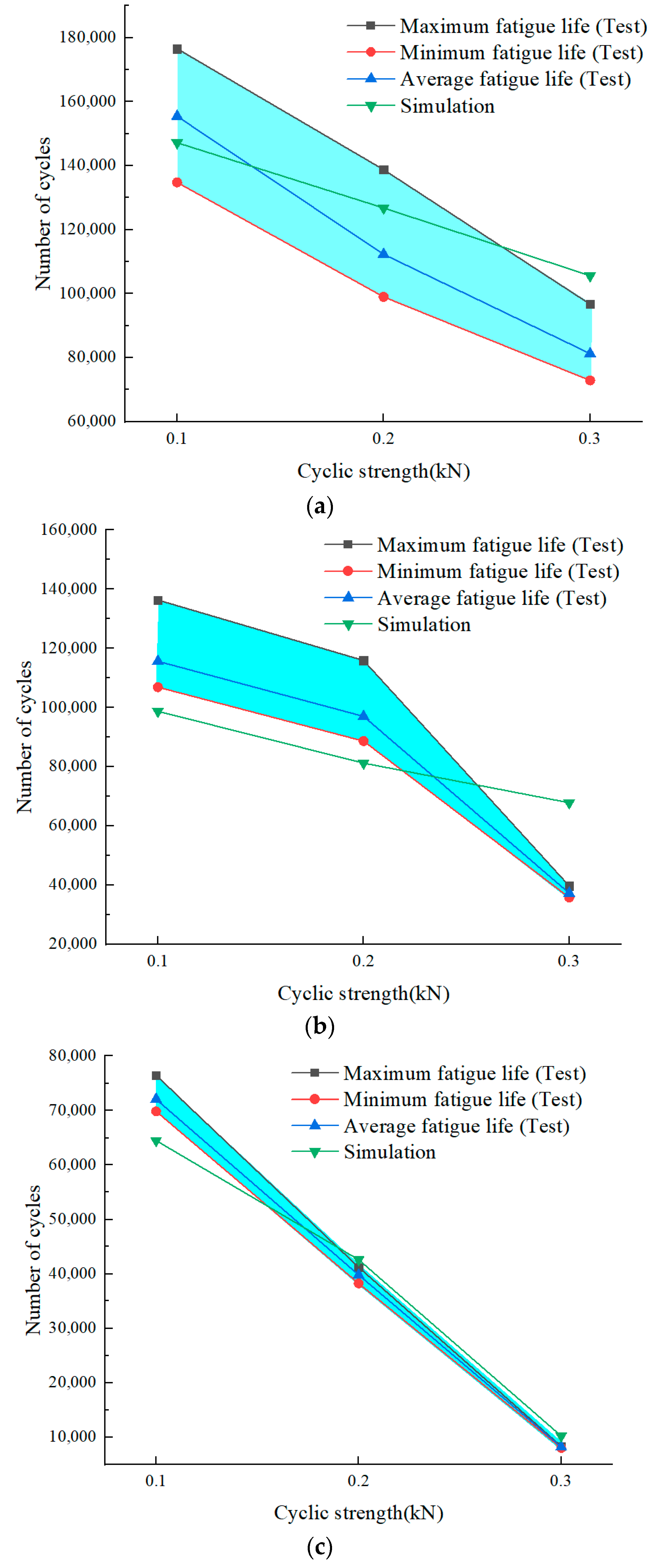

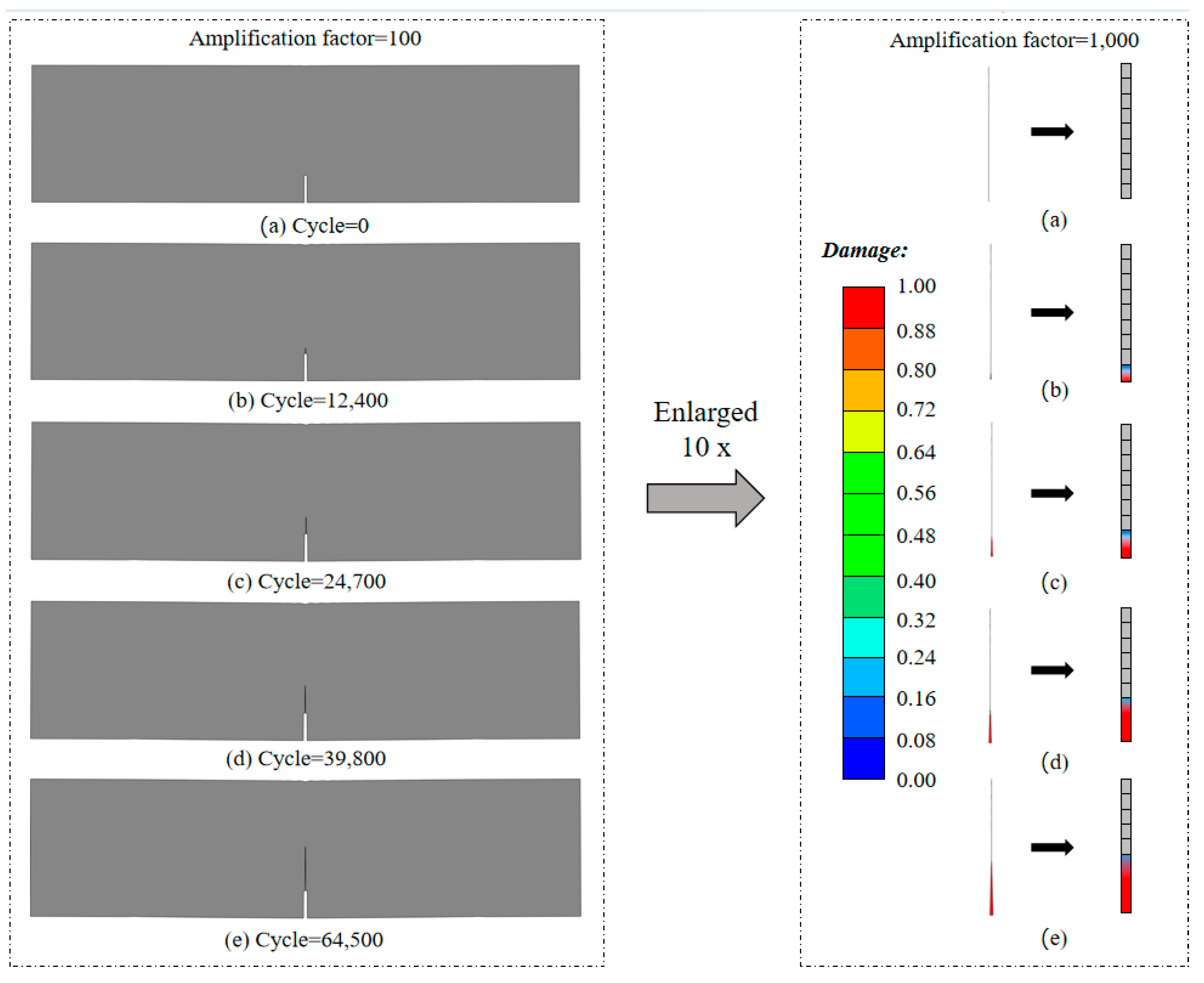
| Interval Time | σmax,0 | Cf | δ0 |
|---|---|---|---|
| 2 h | 0.58 MPa | 0.48 | 0.0007 mm |
| 4 h | 0.36 MPa | 0.42 | 0.0004 mm |
| 8 h | 0.28 MPa | 0.34 | 0.0002 mm |
Disclaimer/Publisher’s Note: The statements, opinions and data contained in all publications are solely those of the individual author(s) and contributor(s) and not of MDPI and/or the editor(s). MDPI and/or the editor(s) disclaim responsibility for any injury to people or property resulting from any ideas, methods, instructions or products referred to in the content. |
© 2024 by the authors. Licensee MDPI, Basel, Switzerland. This article is an open access article distributed under the terms and conditions of the Creative Commons Attribution (CC BY) license (https://creativecommons.org/licenses/by/4.0/).
Share and Cite
Fu, H.-L.; Deng, H.-S.; Wu, Y.-M.; Zhao, Y.-B.; Xie, C.-D. Low Stress Level and Low Stress Amplitude Fatigue Loading Simulation of Concrete Components Containing Cold Joints under Fatigue Loading. Appl. Sci. 2024, 14, 7709. https://doi.org/10.3390/app14177709
Fu H-L, Deng H-S, Wu Y-M, Zhao Y-B, Xie C-D. Low Stress Level and Low Stress Amplitude Fatigue Loading Simulation of Concrete Components Containing Cold Joints under Fatigue Loading. Applied Sciences. 2024; 14(17):7709. https://doi.org/10.3390/app14177709
Chicago/Turabian StyleFu, He-Lin, Huang-Shi Deng, Yi-Min Wu, Yi-Bo Zhao, and Cheng-Da Xie. 2024. "Low Stress Level and Low Stress Amplitude Fatigue Loading Simulation of Concrete Components Containing Cold Joints under Fatigue Loading" Applied Sciences 14, no. 17: 7709. https://doi.org/10.3390/app14177709






